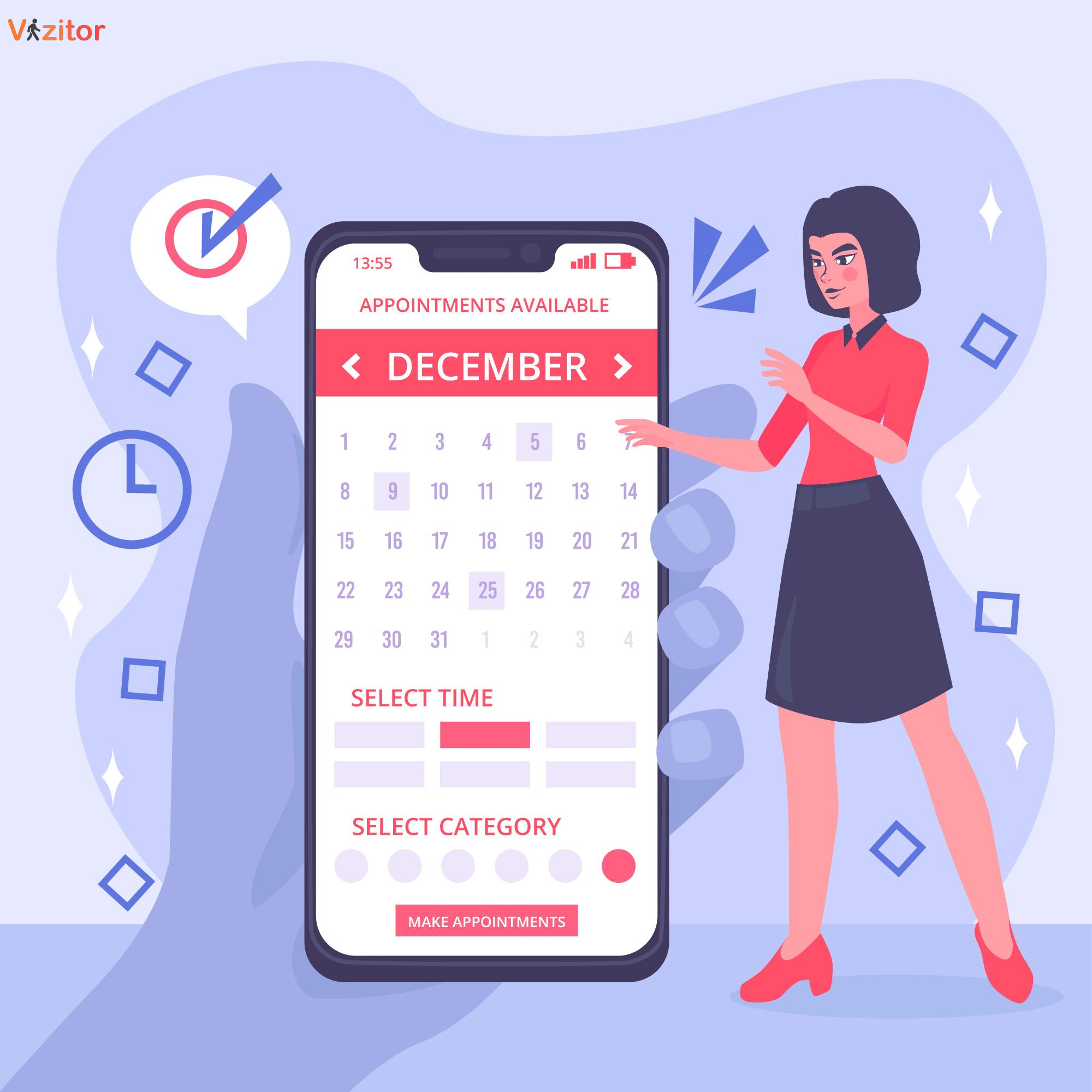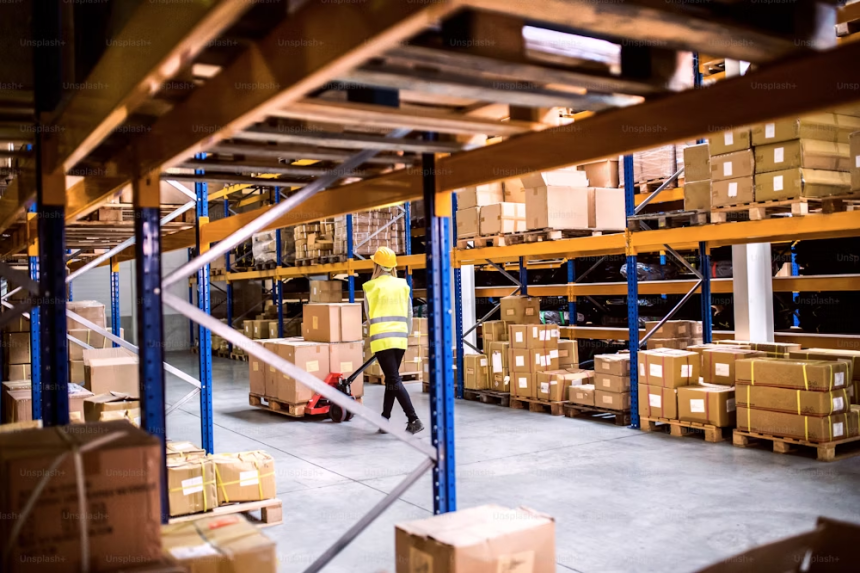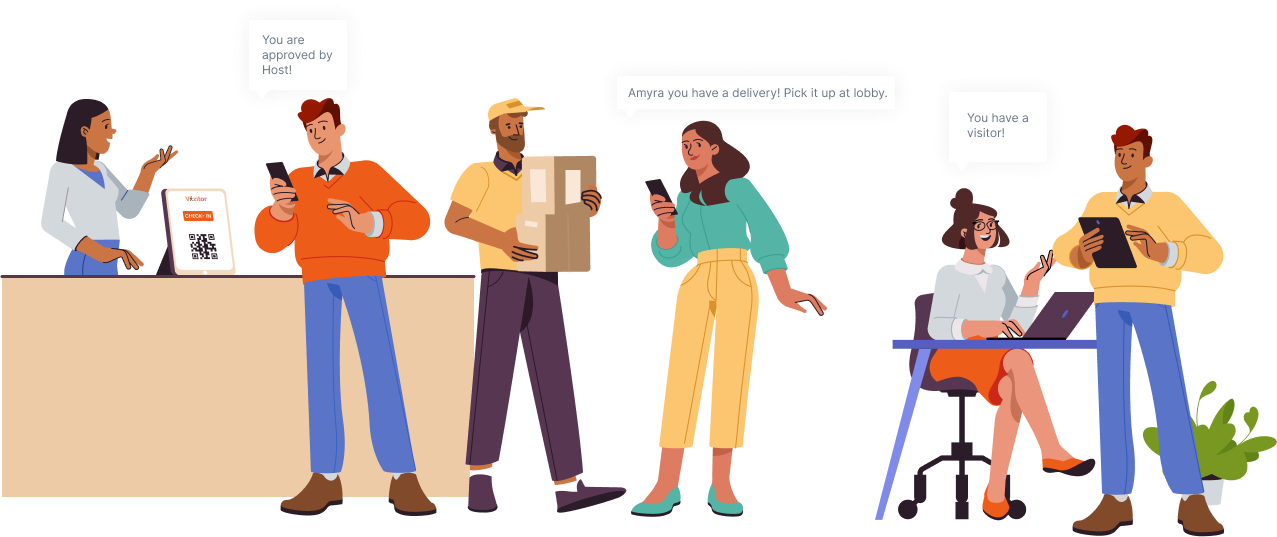Table of Content
Try Vizitor for Free!

Sat, Dec 21, 2024
Read in 10 minutes
Imagine standing in a long line at your local coffee shop, store, or hospital. The minutes feel like hours, and you can’t help but feel frustrated by the inefficiency.
You look at your watch, checking how much time you’re wasting. You start to wonder—how much longer can this go on?
You’re not alone. Thousands of customers face this exact scenario every day, but what if there was a way to skip the line entirely?
In today’s world where customer expectations are at an all-time high, businesses need to keep up with the demand for faster, more efficient services.
One area where this shift is crucially needed is in how companies manage customer queues.
The traditional method of waiting in long lines is not only time-consuming but can also lead to customer dissatisfaction, which directly affects a business’s reputation.
Traditional queue systems have been replaced by Online Queue Apps, offering businesses a smarter, more efficient way to handle customer flows.
These virtual queuing solutions are not just a trend but a vital tool to streamline workflows, reduce wait times, and improve service quality.
In this post, we’ll uncover how online queue apps solve common challenges, improve operational efficiency, and enhance your customer satisfaction.
What are the challenges with Traditional Queues ?
1. Customer Frustration
Whether it’s at the grocery store, a hospital, or a restaurant, long queues are a common cause of frustration. In today’s digital world, customers expect instant service, and long waits can make them feel undervalued.
According to a 2023 study by Statista, over 40% of consumers report feeling dissatisfied with long wait times, leading to a negative perception of the business.
This frustration is not only a threat to customer satisfaction but also makes businesses look for automated queuing solutions such as Virtual Queues.
A restaurant that traditionally had long waiting times during dinner hours can see a rise in negative customer reviews, particularly on social media, complaining about how long they had to wait for a table.
Customers left without making a purchase because they couldn’t bear the wait.
The restaurant experienced a drop in business during peak hours due to customers leaving without making a purchase, highlighting the negative consequences of not managing queues effectively.
Customers’ frustration directly influenced their decision to leave, impacting the bottom line.
2. Lost Sales and Missed Opportunities
The Forrester Research report from 2023 highlighted that 15-20% of customers would abandon a queue if the wait becomes too long.
This leads to lost sales opportunities, as customers leave without completing their intended purchase.
This data demonstrates the need for businesses to adopt queue management systems that help retain customers and reduce abandonment rates.
Retailers heavily rely on in-person foot traffic and sales conversion.
Long queues create a barrier between the customer and the purchase. If a business can’t manage the wait time effectively, they lose out on potential revenue.
Once the store integrated an online mobile queue management system, it was able to reduce wait times, boost customer satisfaction, and recover lost sales.
3. Inefficiency in Resource Allocation
Staff time is the most valuable resource, and inefficient use of it can increase your operational costs. By automating queue management, businesses can reallocate resources to more important tasks, improving overall productivity and reducing the need for additional staffing.
The added expense of staffing and the inefficiency of having employees manage queues are direct consequences of not using modern technology.
By implementing an online mobile queue system, the businesses could streamline operations, reduce the strain on its staff, and lower costs.
4. Overcrowding
Overcrowding isn’t just a discomfort—it’s a safety hazard. Particularly in environments where health risks are present, businesses must find ways to manage crowds effectively.
Online queue apps, by allowing customers to wait remotely or in designated waiting areas, can prevent the congestion associated with physical lines and maintain better crowd control.
The WHO’s report on overcrowding and public safety emphasizes the potential risks associated with crowded environments and the need for better crowd management systems.
Adopting a virtual queue app system can help mitigate overcrowding, reducing the strain on physical space and ensuring that customers can wait comfortably and safely.
5. Inappropriate Data Analysis
Without the ability to track and analyze customer behavior, businesses miss out on opportunities to optimize staffing, improve service delivery, and predict peak times.
Queue management isn’t just about reducing wait times; it’s about gathering actionable data that can drive business decisions.
Online queue apps not only manage lines but also collect valuable insights on customer behavior, peak traffic hours, and service automation.
All these problems associated with the traditional long Queuing processes can impact the workplace efficiency and productivity….
But what if there was a better way? What if customers could simply join the queue without standing in line?
How Mobile Queue Apps revolutionize Your Business Workflows
Long queues are more than just inconvenient—they affect both businesses and customers.
This is where online queue apps come into play. These digital systems allow businesses to manage customer flow with ease, offering numerous benefits for both customers and businesses.
How Online Mobile Queue Apps work?
Online queue apps like Vizitor’s Virtual Queuing System work by allowing customers to join a queue virtually, reducing the need for them to physically wait in line.
Here’s how Vizitor’s online queue system works:
-
Virtual Check-in: Customers can check into the queue via their smartphones or an on-site kiosk, entering basic information like their name, appointment time, or service required.
-
Real-Time Updates: Customers receive real-time updates on their position in the queue via SMS, email, or app notifications, allowing them to wait remotely or at a designated waiting area.
-
Crowd Management: Vizitor helps businesses manage customer flow by monitoring wait times and adjusting service schedules accordingly to avoid overcrowding.
-
Efficient Communication: Customers are notified when it’s their turn to be served, reducing waiting time frustration and ensuring efficient resource allocation.
-
Data Insights: Vizitor provides businesses with analytics on customer behavior, peak times, and service efficiency, helping them optimize operations and improve customer experience.
By streamlining customer queues and reducing wait times, Vizitor enhances both operational efficiency and customer satisfaction.
Benefits of Using Online Queue Apps at your Workplaces
1. No More Long Wait Times—Save Time
- The utmost reason customers abandon businesses or get frustrated is long waiting times.
- Online queue apps allow customers to join a queue remotely, either through their mobile phones or through a simple SMS.
- No more standing around—customers can relax, shop, or even go about their day while they wait for their turn.
A healthcare clinic can integrate a virtual queue system to enable patients wait at home until their appointment time, reducing in-office congestion by 30% and improving the overall patient experience.
According to a study by Statista, businesses that implemented virtual queue systems reported up to 60% fewer customer complaints related to long wait times.
2. Elevate your Customer Experience—Stay Engaged and Informed
- Online queue apps also keep customers informed, providing real-time updates on their position in the queue and estimated wait times.
- Customers can receive SMS or push notifications, so they don’t have to keep checking or wondering about their status.
3. Boost Operational Efficiency
- Staff no longer have to manage physical queues, allowing them to focus on providing better service.
- With virtual queue apps, businesses can allocate resources more efficiently, adjust staffing levels based on demand, and improve service speed.
4. Cost Savings and Resource Optimization
- Virtual queue apps eliminate the need for extra staff dedicated solely to managing physical queues.
- This not only reduces labor costs but also allows businesses to allocate staff to more value-added tasks, like engaging with customers or enhancing their experience.
5. Decrease Safety Risks
- Online queue management helps maintain safe distances between customers, especially in post-pandemic scenarios, preventing overcrowding in waiting areas.
- This is crucial for maintaining health and safety standards in busy places like hospitals, banks, and retail outlets.
How Online Queue Systems Contribute to Sustainability among Workplaces?
As businesses around the world strive to become more eco-conscious, integrating digital queue apps for handling customer flows has become a critical strategy.
Online queue solutions like Vizitor , not only improve operational efficiency but also help reduce the environmental footprint.
Here’s how:
1.Reduction in Paper Waste
- Traditional queue management often relies on paper tickets or printed forms, which contribute to unnecessary paper waste.
- In contrast, Vizitor eliminates the need for printed tickets. Customers can use ticketing kiosks to receive digital tickets, notifications, and updates through apps or text messages.
- This transition from paper-based systems to digital ones significantly reduces paper consumption, contributing to a cleaner, greener environment.
Read more: What is a Ticketing kiosk?
2.Lower Energy Consumption
- Traditional queuing systems often involve physical infrastructure, such as paper printers, digital screens, and lights that are left on in waiting areas
- These resources consume energy, contributing to higher electricity use and carbon emissions.
- Vizitor’s cloud-based software and mobile applications, both of which are much more energy-efficient, use less energy than maintaining on-site servers and infrastructure.
3.Promoting Sustainability as a Brand Value
- By adopting eco-friendly technologies like online queue management systems, businesses signal their commitment to sustainability.
- Customers are increasingly choosing brands that are environmentally conscious, and adopting green solutions like digital queues can be a key differentiator.
4. Effective Space Management
- Vizitor can even track how much space is needed for customers to wait and direct them to the least crowded areas, helping businesses utilize their premises more effectively.
Read more : The ultimate guide to Office Space Management
How Vizitor’s Smart Queue Management System Streamline Workflows?
Vizitor’s Smart Queue Management System (QMS) streamlines the visitor experience, making business workflows smoother and more efficient. Here’s a quick look at how it works:
- Visitor Arrival & Check-In: Visitors check in at the QMS counter and receive a token for the desired department.
- Token Generation: A QMS employee generates a token, directing the visitor to the right department.
- Notification to Department: The relevant department is notified of the visitor’s arrival in real time.
- Visitor Acceptance: An employee accepts the visitor’s request and prepares for their arrival.
- Visitor Transfer (if needed): If necessary, visitors are redirected to the correct department.
- Visit Completion: The visitor completes their visit, having been smoothly directed throughout the process.
Things to Consider While Using an Online Queue App for your business
-
Identify Business Needs: Choose a queue app that fits your specific business requirements, like retail, healthcare, or corporate use.
-
User-Friendly Interface: Ensure the app is easy for both customers and staff to navigate.
-
Scalability: Select a system that can grow with your business and handle increased traffic.
-
Integration: The app should integrate seamlessly with your existing systems, such as CRM or scheduling tools.
-
Real-Time Monitoring: Use apps that provide live updates and reports for better decision-making.
-
Customization: Opt for apps that allow you to personalize the system to match your branding and service flow.
-
Staff Training: Proper staff training ensures smooth operation and enhances customer experience.
-
Security: Ensure the app complies with data privacy laws and keeps customer information secure.
-
Visitor Experience: Prioritize ease of check-in, wait updates, and clear communication for a positive visitor experience.
-
Support: Choose an app with strong customer support for quick resolution of any issues.
By considering these key factors, you can ensure a smooth and efficient implementation of an online queue app solution.
Vizitor stands out as a reliable and scalable solution that not only simplifies your customer flow but also enhances the overall experience for both visitors and staff.
Embrace the power of Vizitor online queue management today and take your customer experience to the next level—where smooth operations and satisfied visitors go hand in hand. Vizitor helps you make that transition effortlessly, paving the way for a more efficient and enjoyable customer journey.
Don’t let inefficiencies slow you down. Get in touch with us to implement our digital Queue Management Solution and optimize your queue management today.
Read more about Vizitor.










